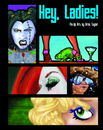Then after a chance remark from an artist friend of mine, I went looking around Golden's website and read an interesting tip about mixing interference colours with a small amount of black, to get a deeper, richer mix. (For the uninitiated, interference colours change between a bright opalescent color and a more subtle complementary colour, depending on the viewing angle. There's a fairly complex mathematical explanation involving the polyatomic interference that results from the meeting of two wavetrains of white light, but for our purposes here, let's just say that the paint contains shiny particles of mica.)
Anyhow, armed with this seemingly minor tip, I got out the paints and tried mixing a few combinations of interference colours and Mars black on the back of a scrap piece of illustration board. Some of them looked great, and others were less than satisfying. But since I was already in laboratory mode, I started adding other paints to the interference colours - some opaque, some transparent. From there things led pretty naturally to iridescents (highly-reflective paints with metallic additives - mica, iron oxide, titanium, etc.).
Before I knew it, I'd come up with a whole slew of options and was practically cackling like a madman. Then I tried photographing the results, which was a challenge in itself. After several tries, I finally came up with these two photos:


Here's a list of the combinations depicted in the photos:
A - interference green + mars black
B - interference orange + mars black
C - interference orange + pyrrole orange
D - interference blue + mars black
E - interference blue + cerulean blue
F - interference blue + phthalo blue
G - interference green + phthalo green
H - interference violet + mars black
I - iridescent pearl + alizarin crimson
J - interference blue + cobalt blue
K - interference blue + phthalo green
L - interference orange + iridescent bright gold (fine)
M - iridescent bright gold (fine) + sepia
N - iridescent bright gold (fine) + pyrrole orange
O - interference blue + dioxazine purple
P - iridescent stainless steel (coarse) + alizarin crimson
Q - iridescent bright gold (fine) + arylide yellow (deep)
This, of course, gives me enough ideas to explore for months. Give it a try yourself and you'll see what I mean.





3 comments:
For someone who is self taught, your approach is very studious and not unlike the best of graduate students or professionals, which you should probably start considering yourself if you don't already. Not trying to heap on the flattery here or anything. It will be interesting to see where this work will lead. I wonder if there is a digital solution to the photography dillema- because I just know that no photos can do these paints justice.
I'm SO blog rolling you dude... I love your style. What I think I like most about your art is your lack of inhibitions, and willingness to try bold new concepts and crazy shit!
If you want to roll me... http://brianstiner.wordpress.com
Keep up the cool art man!
Thanks, guys. Appreciate the comments.
Post a Comment